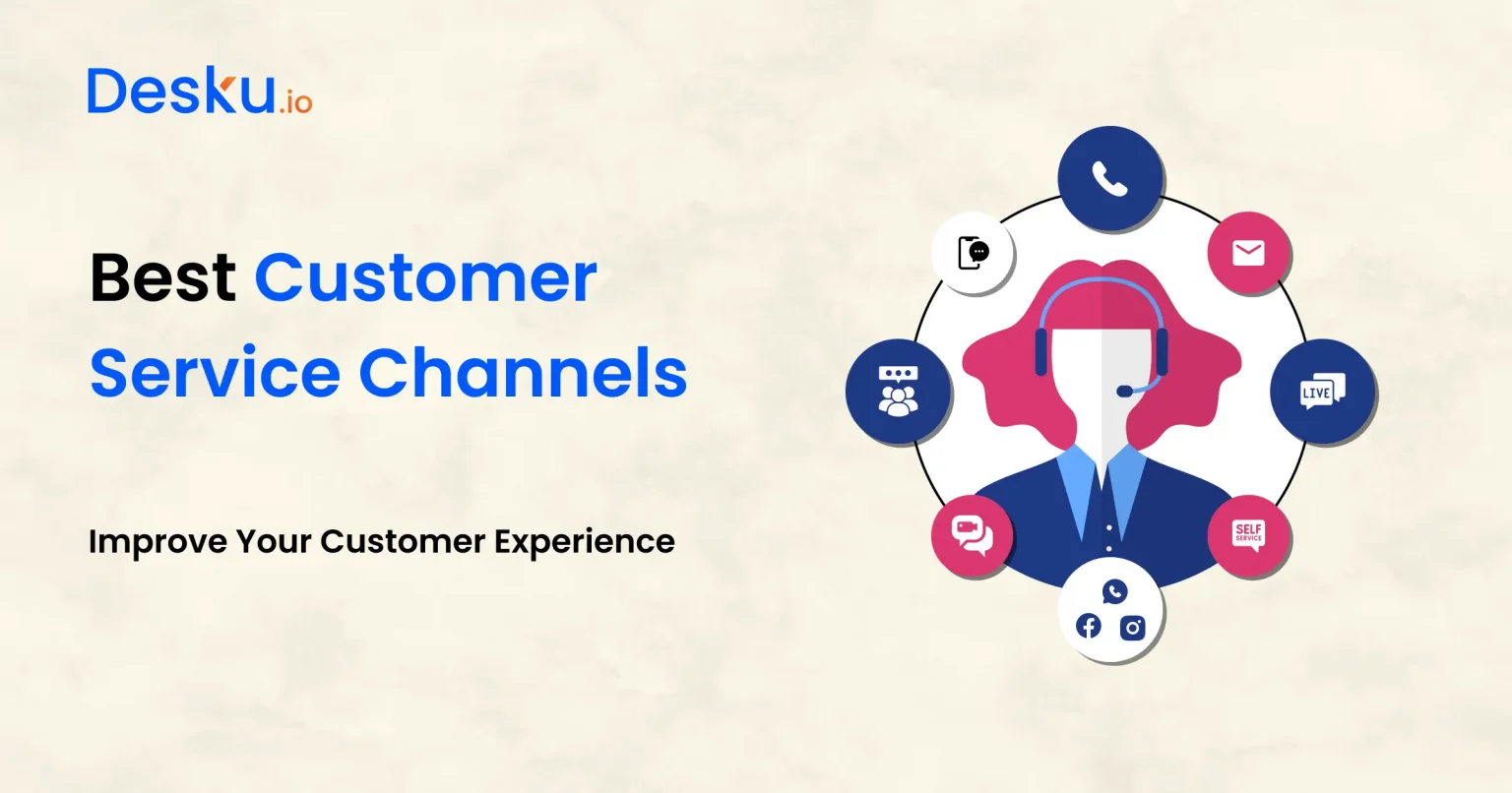Today in customer service world, choosing the best channels to engage with your customers is key. Live chat offers instant responses, and video chat adds a personal touch. Each channel has unique benefits that can greatly improve your customer experience.
By knowing the ins and outs of these top 8 channels, businesses can adapt their approach to meet their customers’ varied needs.
But how can you figure out which channels are the best fit for your business? Let’s delve deeper into this important question.
Key Takeaways
- Use live chat for quick responses and doing multiple things at once.
- Choose phone support for immediate problems.
- Select social messaging apps for strong involvement.
- Consider email support for ease and immense satisfaction.

What Are the Most Effective Channels for Customer Service ?
Without a doubt, the top customer service channels include live chat, phone, social messaging apps, email, and video chat.
Most customers, about 72%, prefer live chat for its speed and multitasking abilities. Phone support is key for urgent problems needing quick action. Social messaging apps give high engagement and are useful for reaching customers worldwide.
Email support is simple and has up to 95% customer satisfaction. Video chat is great for quick, personalized responses, with almost 99% customer satisfaction in some fields.
8 Customer Service Channels That Every Business Should Consider
Businesses should think about customer service channels. They should focus on phone, email, live chat, self-service options, and social media. These channels give many ways to talk to different customer needs and likes.
1. Phone
Customer service strategies use many channels. The phone is a key tool for the best customer satisfaction.
- Phone support gives an 86% customer satisfaction score.
- Real-time talk helps with fast help and solving urgent problems.
- Personal talks lead to more happiness, especially with hard or sensitive issues.
- It is perfect for quick help with urgent problems, giving customers a feeling of value.
- The human factor in phone support builds loyalty and customer happiness.
2. Email
Email is a key customer service channel. It’s widely used for handling non-urgent questions and keeping written records of talks. More than 4 billion people globally use emails.
This method is great for handling many questions at once. It’s useful for companies across the world dealing with language and time differences. Emails give a written record of talks. This makes it good for detailed explanations and keeping a formal tone.
Email support lets agents reply when they can, making customer service efficient. It is a good support method for businesses wanting to manage questions formally and communicate well.
3. Live chat & Chatbots
Live chat, supported by AI customer service technologies, is essential for modern businesses aiming to enhance customer interactions and satisfaction. With 72% of customers preferring live chat for brand communications, it offers immediate and always-available support.
AI chatbots further streamline this process, enabling simultaneous handling of multiple inquiries. This technology not only tracks crucial information but is also straightforward to integrate into websites.
Featuring the highest customer satisfaction rate at 73%, live chat combined with AI chatbots efficiently resolves queries, leading to improved conversion rates. Customers value the quick and effective responses they receive, which greatly benefits the business.

4. Self-Service
Self-service channels are critical in today’s customer service strategies. They let customers solve issues on their own, boosting overall support speed.
| Key Points |
|---|
| Cuts support costs |
| Strengthens customer knowledge |
| Makes problem-solving more efficient |
| Boosts customer happiness |
5. Social media
Social media platforms are key for customer service. Every business should think about adding them to their support strategies. Social media lets you connect with customers in real-time.
This builds trust and promotes future interactions. Answers on social media are public, helping other customers with similar issues or questions.
Companies such as Slack and Buffer do a great job at providing customer support through social media channels. Social media support helps to lower churn rates and keep your brand visible in the digital age.
Social media channels are key for customer support.
Social media lets you connect with customers in real-time.
Public answers on social media help multiple customers.
Companies such as Slack and Buffer do great in social media support.
Social media helps keep your brand visible and lowers churn rates.
6. Video chat
Video chat is a powerful tool for customer service. Businesses should use it as part of their support strategies. Known for quick responses and personal experiences, it boosts customer satisfaction. It also increases customer engagement through face-to-face talks. This leads to higher satisfaction rates.
Customers who need immediate help and real-time support prefer it. It lets businesses solve complex problems with speed. Some sectors report nearly 99% customer satisfaction rates with video chat. This shows its power in building customer trust.
Businesses can use video chat as part of their all-channel support approach. This way, they can provide top-notch service, build stronger ties, and meet customer expectations well.
7. Communities and forums
Forums are vital in improving customer support and boosting brand loyalty.
- They aid in peer-to-peer support, bolstering client relations.
- User content on these platforms cuts support costs and ramps up customer engagement.
- Joining these discussions promotes knowledge sharing. It enables customers to fix issues on their own.
- These platforms offer a place for customers to bond, which strengthens brand loyalty.
- Use of such community support channels can cut support ticket numbers and improve customer satisfaction.
8. Mobile messaging
In the customer service field, mobile messaging is a key player. It is easy to use and quick. By 2025, over 3.5 billion people worldwide will use mobile messaging apps. This makes it a favored customer service tool.
Apps like WhatsApp and Facebook Messenger are handy. Mobile messaging is a key part of digital customer service plans because of its wide reach. In fact, 97% of people in the US have cell phones. Since all mobile devices have it, mobile messaging is easy and familiar for customers needing help.
It lets businesses talk directly to customers in a personal way. This boosts the customer experience.

5 tips for most effective customer Service channel
To improve customer service channels, firms should prioritize essential tactics.
They must craft an omnichannel approach, suited to their operations.
Ensuring mobile-friendly platforms is also crucial.
Businesses need to weave personal interactions into their service.
Routine tasks must be automated.
Finally, they need to have service level agreements in place.
By following these guidelines, companies can smooth out their customer service operations.
They can offer customers a flawless experience on various channels.
This would lead to excellent customer engagement and retention.
Define omnichannel for your organization
Adopting an omnichannel approach in your organization means blending different communication channels. These may include phone, email, chat, and social media. The goal is to give customers a smooth and comprehensive experience.
- It’s crucial to know your customers’ likes and habits to build a solid omnichannel plan.
- Using automation can make managing many communication channels more efficient.
- Tailoring communication across channels can make the customer experience more engaging.
Omnichannel support can cause a 140% increase in spending and 5-year longer customer loyalty. This shows its effect on customer loyalty.
Good experiences across various channels boost customer loyalty and satisfaction. This makes omnichannel a vital plan for improving the customer journey.

Optimize everything for mobile
To serve customers best, think mobile-first. Today’s world is mobile-driven. Mobile optimization increases customer engagement and satisfaction. A mobile-friendly design makes interaction easy. It gives a good user experience on all devices.
By looking after mobile users, businesses can attract more people. They can meet the needs of modern, on-the-go consumers. Over 50% of web traffic comes from mobile devices. This shows the mobile-first trend in communication and interaction.
Mobile responsiveness in customer service channels is key. It creates a customer-focused approach. This drives customer satisfaction and loyalty.
Build personalization into your customer support
Incorporating tailored communication approaches into customer support channels is key to building strong customer loyalty and satisfaction. Here are some methods to do this effectively:
- Use omnichannel support to provide a smooth experience across different platforms.
- Make use of CRM integrations for steady, personalized communication based on individual likes.
- Study customer behavior to better understand their wants and likes.
- Alter offerings based on what customers prefer to increase their satisfaction.
- Include customer feedback in your strategies to consistently improve tailored interactions.
Automate common and repeatable tasks
To improve customer service and user experience, businesses should automate everyday tasks. Tools like chatbots can handle routine inquiries with high efficiency, solving up to 80% of them. With automation, customer service response times can drop by 80%. This leads to happier customers.
Automation also increases agent productivity by 25%. Agents can then focus on harder issues that need human help. Chatbots offer support 24/7, improving customer service availability. Automation simplifies processes and cuts customer service operational costs by 30%. This makes it a key tool for businesses aiming for top-notch omnichannel customer service.
Set up SLA policies
Setting up Service Level Agreement (SLA) rules is key. They give clear guidelines on response times and solving issues across all customer service channels.
- SLA rules ensure on-time responses and effective problem-solving.
- Set SLAs keep uniformity in handling customer queries across all channels.
- Clear rules boost responsibility and openness in customer interactions.
- Adaptable SLAs meet different priorities, channels, and customer needs.
- Checking SLA adherence provides a clear view of how each customer service channel performs.

How to Decide Which Customer Service Channels to Use
To pick the best customer service channels, consider some things.
Know what your team can do.
Identify what your customer needs.
Look at your resources.
Watch how your customers behave.
Use data.
With a close look at these, you can make smart choices.
You’ll know what channels to focus on for a good customer service plan.
1. Know Your Team’s Capabilities
Determining your team’s abilities is key. This understanding helps choose the right customer service channels. The goal is to boost performance and satisfy customers.
- Think about the training and resources required for each channel. This ensures efficiency.
- Measure your team’s knowledge of different customer service channels. Also, consider their success rate.
- Look into the difficulty of problems your team can solve on various channels.
- Pair the difficulty of customer questions with the right channels.
- Think about each channel’s growth potential and adaptability. This should match your team’s abilities.
2. Identify Your Customer’s Needs
After looking at your team’s skills with different customer service tools, the next step is to study customer habits and likes. This helps to decide which tools to use. Look at customer happiness scores, how urgent their questions are, and who your customers are. This helps to shape your approach. Here is a table showing important points to consider when learning about your customer’s needs:
| Points to Consider | Examples | How Important They Are |
|---|---|---|
| Customer Habits | Their favorite ways to communicate | High |
| Customer Likes | Tools they are happy using | Medium |
| Urgency of Questions | Fast answer needed | High |
Keeping these points in mind will help you to choose the best customer service tools for your business.
3. Evaluate Your Resources
To pick the best customer service channels for your business, you need a careful check of your resources. Think about these factors when choosing channels:
- Customer Traits: Study your target audience’s features and likes.
- Team Size and Skills: Check your team’s ability and know-how to handle various channels well.
- Growth Potential: Make sure the channels can meet rising needs and a growing customer base.
- Value for Money: Look at the costs of starting and keeping up each channel.
- Customer Thoughts: Use feedback to see which channels meet customer needs and make them happy.
4. Observe Customer Behavior Patterns
Watching how customers behave helps businesses to choose the best service channels. This analysis shows which communication methods customers prefer. It considers things like age, generation, and where they live.
Using data from customer satisfaction scores across different channels helps decide the best platforms for customer engagement. It’s important to look at response times and how much customers engage on each channel.
Monitoring customer feedback and trends helps businesses keep improving their channel choice. This improves the customer experience and satisfaction. This method makes sure customer service efforts match what customers prefer and expect.
5. Utilize Analytics
Analytics use is key in pinpointing effective customer service channels. This is done by using customer behavior data, shaping business approach to align with preferred communication channels.
It’s important to keep track of customer engagement and satisfaction on different platforms. This helps make better decisions. Keep an eye on response times and resolution rates. This offers clues about a channel’s efficiency.
Customer feedback and surveys are vital for understanding preferences and areas to better. Look at conversion rates and customer retention figures. They help measure the effect of different customer service channels on business success.

Conclusion
In conclusion, companies can boost customer experience by using diverse customer service channels. A key statistic is that 64% of customers want immediate responses and interactions from companies.
By employing methods like live chat, phone support, and social media, businesses can meet customer needs and raise satisfaction.





